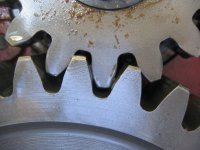browns40
Gold Member
Hi Alan,
Sorry to hear you (& the machines) had a trying week...
Again, family is family, so all's forgiven... maybe next time you can be on the tractor... where he's a fellow tractor man this may be opportunity to check out areas on his to watch for just in case (?).
I wouldn't trust any out of the box slip clutch... sitting in perfectly dry warehouse conditions still seems to cause them to bind together...
Here's how to adjust:
1. Get a "feeler gauge"; paint stirrer, nail, file, metal rule--whatever fills the space of the "set" spacing on the clutch in work shape.
2. back the nuts compressing the spring out flush to the ends of the bolt.
3. scribe a line across all parts of the clutch with crayon, paint, chalk--whatever, so you can be sure it's slipped
4. engage the implement at 1500 or so RPM's... a puff of clutch material/dust/rust sometimes blows out. Push up RPM's. Back to idle. Stop PTO, repeat 3, 4, 5 times (polish the faces). (may need to engage at higher RPM's if plates are really froze up)
5. tighten nuts down to spacing of your feeler gauge, OR, in this case, where you're overimplemented, leave slightly more of a gap to encourage slipping at lower forces than "factory"
You're done. Plan on checking for slipping any time you let the shaft sit idle for any amount of time, especially in damp conditions.
Again, sorry about the damage...
Sorry to hear you (& the machines) had a trying week...
Again, family is family, so all's forgiven... maybe next time you can be on the tractor... where he's a fellow tractor man this may be opportunity to check out areas on his to watch for just in case (?).
I wouldn't trust any out of the box slip clutch... sitting in perfectly dry warehouse conditions still seems to cause them to bind together...
Here's how to adjust:
1. Get a "feeler gauge"; paint stirrer, nail, file, metal rule--whatever fills the space of the "set" spacing on the clutch in work shape.
2. back the nuts compressing the spring out flush to the ends of the bolt.
3. scribe a line across all parts of the clutch with crayon, paint, chalk--whatever, so you can be sure it's slipped
4. engage the implement at 1500 or so RPM's... a puff of clutch material/dust/rust sometimes blows out. Push up RPM's. Back to idle. Stop PTO, repeat 3, 4, 5 times (polish the faces). (may need to engage at higher RPM's if plates are really froze up)
5. tighten nuts down to spacing of your feeler gauge, OR, in this case, where you're overimplemented, leave slightly more of a gap to encourage slipping at lower forces than "factory"
You're done. Plan on checking for slipping any time you let the shaft sit idle for any amount of time, especially in damp conditions.
Again, sorry about the damage...



